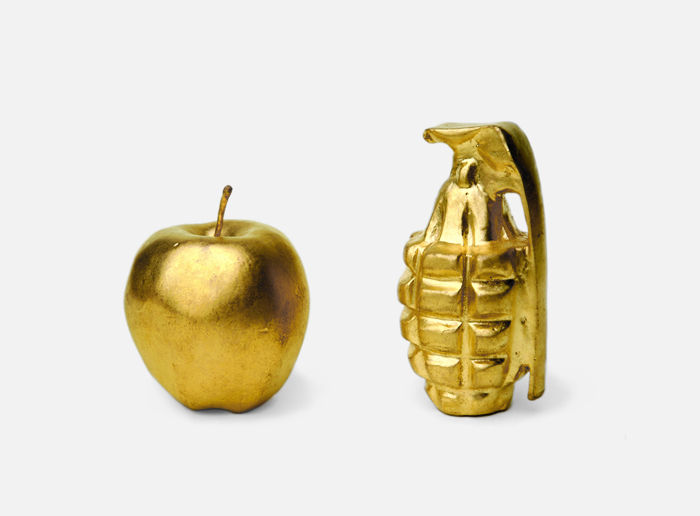Heaven and Hell Meet in Berlin

Image of “Temptation” courtesy of Awst-Walther
Berlin and Hieronymus Bosch’s 1503 triptych, “The Garden of Earthly Delights” is the divine inspiration for “Earthly Delights, Tape Modern No.11,” a show of 13 Berlin-based artists curated by Anna Erickson and on view for three nights at Berlin’s nightclub-cum-exhibition space, Tape Modern.
“The Garden of Earthly Delights” runs during Artforum Berlin, but delves into deeper and darker regions than most of the fair’s saleable fare, providing a platform for a group of new-ones to-watch in the local arena. Few of the works reference Bosch explicitly, but they all dig into the core themes of redemption, morality, and mortality depicted in “The Garden of Earthly Delights.” And, they mostly share an intensely surrealist aesthetic that evokes the phantasmagorical appearance of Bosch’s vision of heaven, hell and creation.
For the three-night run, the longest that Tape Modern has ever hosted for its series of popular flash art exhibitions by local curators and artists such as Israeli artists Amir Fattal and Ariel Reichman, Erickson will transform the main exhibition hall of the show space-cum-nightclub into a burlesque-like lounge. For the opening, Peruvian-born and Berlin-rooted based Kenno Apatrida, an artist whose shamanic shrine-like sculptures and installations are often compared to Bosch’s imagery, will present a performance blending his signature death-masks and nudity into a bacchanalian orgy.
“The show is less of a literal interpretation of Bosch, than a collection of works addressing similar themes with comparably extreme imagery,” Erickson says. “I like that one scholar described Bosch’s painting as ‘the nightmare of humanity’, where ‘the artist’s purpose above all is to show the evil consequences of sensual pleasure and to stress its ephemeral character.’ That statement also applies to all the artists I selected.” Erickson got to know many of those artists when she lived in Berlin between work at the Gagosian gallery in Manhattan and her current post as the Associate Director of Yvon Lambert’s New York branch.
American-born painter John Miserendino indirectly references Bosch with his updated, abstracted version of Peter Brueghel the Elder’s nightmarish “The Triumph of Death,” which hangs in the Prado Museum directly across from “The Garden of Earthly Delights.” A more subtle link exists between the gold-plated apple and grenade, exhibited ubiquitously by husband and wife artist team Awst-Walther. “In a world where sin exists, our piece asks what delight is not full of sin?” they explain, speaking as one. “That’s how we think our ‘Temptation’ relates to Bosch’s painting.” Visual parallels to Bosch emerge from Torsten Solin’s photographs of extremely distorted babes paired with taxidermy familiars who would fit in nicely with the fornicating hybrid humans, beasts and plants that populate Bosch’s painting.
One of the most show’s bewitchingly bizarre and articulate commentaries on the subject of sin and temptation is the tiny all-white-and-red twin series of sculptures titled “9 Scenes of Ordinary Murders,” by young Greek artist Angela Liosi. Both series consist of matchbook-sized murder scenes made from architectural model materials and red nail polish set in different domestic environments, like a game of Clue directed by Eli Roth.
Liosi devised her micro-murders as a means of exorcizing common and innovative morbid fantasies. In them, her tiny and entirely white characters cut each other up while another one reads the newspaper, they sit idly while their companion gushes red blood at the other end of the sofa, they pull apart each other’s bodies with clothing line, and impale each other during a private pilates session.
Liosi’s scenes evoke Patricia Highsmith’s succinct, sinister, and physiologically razor-sharp short story collections Little Tales of Misogyny and The Animal-Lover’s Book of Beastly Murder. Like Highsmith, Liosi uncovers the dark desires within apparently normal, bland individuals. Her minute white figures are indistinguishable to viewers but are apparently fleshed out sufficiently elicit pure sadism or vigilantism in one another. Like their companion pieces, Liosi’s works do not explicitly illustrate the bliss of paradise or the torments of hell, but they do illustrate the secret toxic urges we struggle to suppress, before they lead to the damnable sins Bosch warned would send us to a hell as awful as the one he depicted.
The Tape Club is located at Heidestrasse 14 in Berlin. “Earthly Delights” is on view through September 27th.






